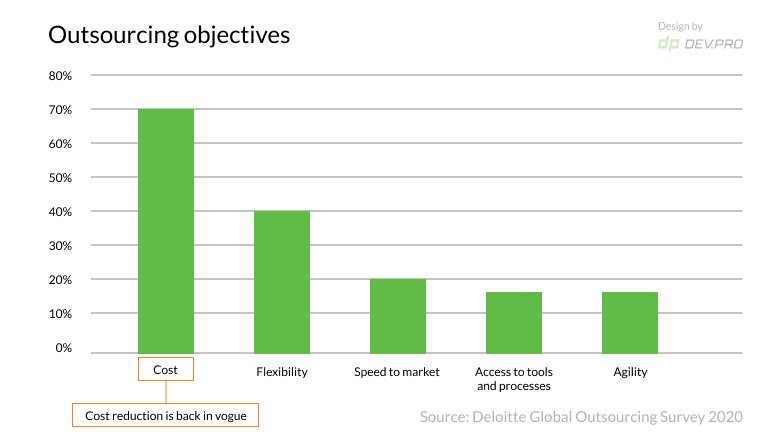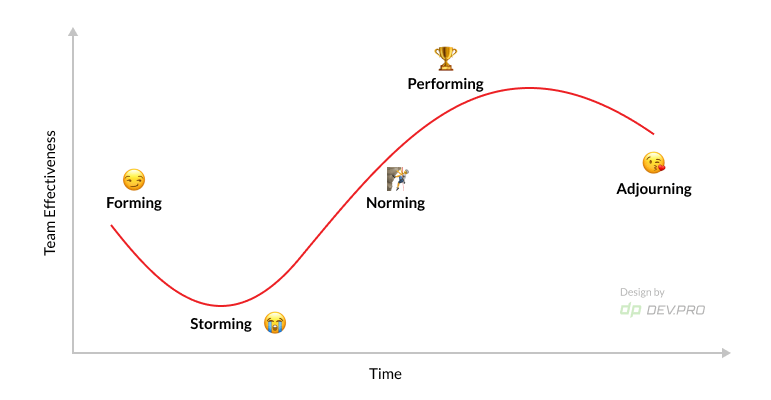Many scale-ups have jumped on the outsourcing bandwagon to cut costs and accelerate their in-house team’s expertise. They face a mission as major as creating a brand new team. According to Deloitte, companies use outsourced software engineers for these reasons: lower costs [70%], better flexibility [40%] and quicker time to market [20%].

However, when you decide to add new members to your team, you’re also adding a new challenge. According to an educational psychologist Bruce Tuckman, even one new team member changes the team’s dynamics, structure and hierarchy.
Truckman’s model of stages of Team Development will help you anticipate, recognize and proactively address each phase of group formation:
- Forming [social interaction and searching for leaders, tasks, roles]
- Storming [questioning and challenging stage, a leader emerges]
- Norming [leaders are acknowledged and duties are distributed, processes becomes smoother]
- Performing [high-performance stage with clear understanding of all processes and missions by all members]
- Adjourning [completion of the project, dissipation of the team]

| Forming | Storming | Norming | Performing | Adjourning | |
| Team’s morale | The team feels insecure and stressed about the present and future | The team feels violated by the change, and hostile | Overwhelmingly positive, yet ambivalent state, which is fragile and may go back to storming | Full swing model, there’s no looking back, all conflicts are in the past, and productivity is high | Full of satisfaction for the accomplished mission and ready to move on and up. Somewhat nostalgic |
| Team’s behaviour | The team’s starts interacting, trying on new roles and testing procedures | The team find their way around new methods, look for the leader and the order | Members start active communication and efficient collaboration with rare fallouts | The team work smoothly together on the project with well-oiled procedures and tried tools | The team finalizes the project and starts looking for new opportunities |
| Leader’s role | To communicate change and relay the pluses of the situation | To relieve stress. To help gain footing and direction in new hierarchy | To help leaders strengthen the new norm. To mitigate any recurring conflicts. | Maintain positive team dynamics and morale. | To instill the spirit of accomplishment and job well done. To secure the best of the team to prolong cooperation on other projects |
| Leader’s actions | + To hold an introductory meeting warming the in-house team to the idea of a hybrid mode. + To involve the in-house team in decision-making & vendor selection in the prior stage | + To help avoid and navigate any conflicts with minimal detriment + To provide tools and formats for seamless communication with the new team | +To have weekly syncs and one-on-ones with the top & bottom performers. +To mediate conflicts | +To create a fair and transparent bonus and incentive system in place +To ensure the team has social life and meet-ups that allow them to connect +To provide cross-visit opportunities between offices | +To hold regular progress meetings. +To ensure a project-end farewell party or celebration. +To hold talks about the top talent future with the company’s other projects |
These team development stages are the result of scientific observation, so you can rely on pretty much any team to go through a similar cycle. This blueprint will help you mitigate the upcoming risks and precipitate the onset of the Performing stage.
Based on our 10 years of experience as an outsourcing vendor, here are some recommendations on how to integrate an in-house team of software engineers with an outsourced team.
DOs of Integrating the Outsourcing Unit into your In-house Team
Successfully combining software engineers from different parts of the world is a survival skill many scale-ups prefer to master early on.
Spend Time Selecting your Outsourcing Vendor
Due diligence is a stage that may seem rudimental in this fast-paced world, but the return on investment will come through in more ways than one.
Send out Requests for Proposal to at least three companies in at least three destinations to have a well-rounded understanding of the offering.
When in the process of vendor-hunting, ensure you are happy with:
- Responsiveness to the RFP and style of communication
- Level of detail and expertise exhibited in the supplied documentation,
- Clarity and level of nuance of the estimates and roadmaps,
- Portfolio of related cases in similar business verticals.
Provide 360-Degree Visibility to Both Teams at All Times
In our decade-plus of experience, we’ve found that it’s essential to communicate when the following events occur:
- A showstopper occurs that makes progress impossible or slows the project down
- There is a delay in production due to third-party performance
- There is a technical error that is likely to disrupt the work or have some long-time implications
- There is data about a potential situation that may impact your project. Conversation allows both teams enough time to come up with a contingency plan.
Use Reporting and Analytics to Monitor, Adjust, and Prognosticate
Having a meticulous list of reports hitting your inbox on a daily / weekly / monthly basis will help you keep your finger on the pulse of progress.
DevPro’s tech partners sometimes expect a regular overview of the major metrics of the project. These include:
- Velocity / Capacity
- Focus factor
- Defect density to monitor the quality of deliverables
- Burndown charts for scope
DON’Ts of a Software Engineering Hybrid Model
Don’t Use Scrum. Instead, Use Scaled Scrum
The framework for project management of the multi-team multi-task missions is the pillar of discipline among chaos, that substantially easies the complexity of the multi-layered work process, reducing frictions and providing clarity. There are several products on the market, which work on frameworks likeAgile [Scrum] or a KanBan.
For instance, the Nexus framework helps Dev.Pro dedicated teams move along their respective projects in close cooperation with their in-house based counterparts, even on the other side of the globe.
It’s still Scrum, but it’s Scrum on steroids, specifically designed for multi-vector, multi-team collaboration.
Don’t Base your Financial and Delivery Expectations on Ballpark Figures
Math is a friend of a scale-up.
Go as detailed as possible into budgeting. Have a few scenarios, from conservative to optimistic. When the time comes, the neuron connections will be in place for you to take the next calculated step.
Never Overlook The Fine Print
When selecting your outsourcing services provider, pay attention to the fine print.
This is even more important if this is your first partnership with the company. Asking questions before signing a contract is as wise as doing so after is senseless.
Tips & Best Practices: How To Team Up Outsourced Software Engineers and In-House Team
- Hold in-depth discussions with C-level executives on rollout, Key Performance Indicators, and expected outcomes.
This is a big change that will have far-reaching repercussions on the future of your company. Ensuring your c-suite members are onboard will set the stage for the rollout.
- Pay attention to methodology and tools
You need to get technical at the vendor selection stage and contract signing so that to avoid going over initial financial and time constraints.
The more detail you exchange and agree upon with your potential extension team vendor in terms of programming languages, frameworks, servers, tools, and platforms, the smoother the collaboration will be.
Dev.Pro’s dedicated outsourced teams use these tools for timely and orderly project communication:
- Jira for workflow management and task tracking
- Confluence for project requirements management
- Microsoft Teams for communication
- Establish mirror-like two-way communication across all layers
Meshing your two teams into one is a basic yet fundamental mission. Get the channels, tools and infrastructure in place so that newcomers feel welcome and up to date.
The following set of standups, syncs and retros helps DevPro’s dedicated teams ensure the balance of meeting-to-work efficiency:
- Team standups: daily 15-minute meetings for each Scrum team, where each person reports on what they did yesterday, any show-stoppers or delays, and plans for the day.
- Nexus standups: daily 15-minute meetings on the tech lead / PM level, where each team’s issues and plan are set out by their reps and incorporated into the bigger picture. The feedback from the Nexus meeting is then trickled down to teams. This is a common meeting where in-house and outsourced teams touch base on a daily basis, so it’s scheduled in the earliest time possible for 2 time zones.
- Retrospective meetings: a retro meeting for teams that is held with each iteration or every 2 iterations, depending on how frequently you onboard.
- C-level meetings: as per business requirements. This format usually includes CEO and c-suite level decision makers on behalf of the in-house team and delivery director and tech leads on behalf of the outsourced team. They are as long and as frequent as the business needs dictate. Any resulting outcomes are then communicated to the teams.
- Involve your team in designing systems that welcome a new branch of the company
The more involvement your current in-house team gets in designing the very infrastructure of collaboration, the smoother the transition period will be.
They should know that their jobs are safe and that the extension team is an opportunity rather than a threat. They will be able to offload work and gain insights into new programs, procedures, languages, and frameworks.
You might want to do a survey or ideation call with your team how they would like to be introduced to a new team suggesting different formats, including:
- Informal online breakfast with a randomly chosen buddy from across the globe.
- A company-wide draw where any team member can join a C-level team on their trip to a dedicated team office with all expenses covered.
- An online wine tasting with the same tasting kits shipped to all team members that include wines from both countries.
Making the Best out of Hybrid In-house + Outsource Team Model: Mission Possible
According to Statista, the total global revenue of the outsourcing market in 2019 reached $92.5 billion, with over 2/3rds of it in ITO [$66.5 billion] and $26 billion in BPO.

Source
Globalization, omnipresent work from home culture, and cut-throat competition in the tech industry are pushingAmerican and European companies to strengthen their in-house development crews with extended development teams.
After all, this is probably one of the few scenarios available to scale your product quickly without burning through your initial capital before proving your idea is worth further investment.
With over 160 projects completed over the past decade, DevPro has software engineers with every skill, programming language, and framework command across a range of verticals, including Cloud, Data analytics, DevOps, QA, Software architecture.
If you ever need to scale your product quickly, our sales team can provide you with an estimate for your specific needs.

